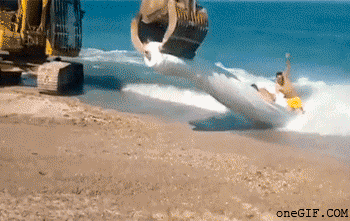- Compound Learning
- Posts
- Innovator's Dilemma Part II: From Hand-Dug Holes to Hydraulic Hoes: The Wild Evolution of Excavators!
Innovator's Dilemma Part II: From Hand-Dug Holes to Hydraulic Hoes: The Wild Evolution of Excavators!
The story of sustaining and disruptive innovation. Lets dig in😆
Howdy, folks!
estimated read time: 3 minutes
Let's talk about William Smith Otis, the dude who invented the first steam shovel back in 1837. For almost a century, steam-powered excavators were the kings of the construction site. But in the early 1920s, gas-powered engines hit the scene and everyone was like, "Ooh, smaller and more powerful! Sign me up!"

But despite the gas engines' awesomeness, excavators were still basically the same old cables-and-pulleys deal. They were faster and more efficient, but nothing groundbreaking. That's why 23 out of the 25 biggest steam shovel manufacturers were able to switch over to gas engines without any trouble.
Then came the diesel engine in 1928, which allowed for the arched boom design after World War II. And yeah, these were improvements, but nothing disruptive. Just the same old steam shovel makers churning out slightly better excavators.
But then, from the late 1940s to the 1960s, a new technology emerged: hydraulics🎉. And let's be real, when hydraulics first came out, they kind of sucked. Here's why:
See, steam shovel companies' best customers were contractors who wanted bigger shovels and longer reach. There were three types of big-time excavator customers:
sewer and pipe contractors (who needed small buckets)
general excavation contractors (who used buckets that were about 2.5 cubic yards)
the big dogs, the miners (who rocked 5 cubic yard shovels)
And every year the steamers gave them more of what they wanted. Bigger buckets! On average the size of these buckets increased by 4% each year.
But when hydraulic excavators first hit the market in 1947 (shoutout to J.C. Bamford!), their biggest buckets were only 0.25 cubic yards and had a maximum reach of just 6 feet and to top it off they could only rotate 180 degrees, while steam shovels could do a full 360.
So none of the sewer folks, general excavators, or miners were interested.
But the hydraulic manufacturers didn't give up. They found a new market: residential contractors who already had tractors and needed to dig narrow ditches for water and sewer lines. These guys couldn't afford a steam shovel and didn't have the space for one, anyway. But with a hydraulic hoe, they could knock out a trench for a typical job in less than an hour per house.

These early hydraulic users didn't care about bigger shovels. They just wanted something fast and maneuverable. And that's where sustaining innovation becomes a game-changer.
Fast-forward a few years and the hydraulic excavator was crushing it. In 1955, the bucket size was up to ⅜ of a cubic yard. By 1960, it reached ½ cubic yard. In 1965, it hit 2 cubic yards. And by 1974, it could move a whopping 10 cubic yards!
Suddenly, hydraulic excavators could meet the needs of everyone from low-end residential contractors to the big-time miners. The old steam shovel makers tried to keep up, but they were too set in their ways. And by the end, only four of them were still standing.
Bucyrus one of the dominant steam guys tried making a hybrid, hydraulic and cable. But, it wasn’t great. They were trying to adapt hydraulics for their existing customers rather than selling hydraulics to people with the needs.
The steamers recorded record profits up until 1966. That is the point where hydraulic shovels got good enough to start serving the needs of the sewer guys and the general contractors in terms of bucket size, reach, and rotation. But… they were also faster, more precise, and more nimble.
This is why all but four of them died.
The tricky thing is that steamers didn’t do anything wrong. Sound management says that they needed to keep focusing on their customer’s needs. If they backed off of the sustaining innovation it would have put their existing business at risk. It was a lot more profitable for these companies to keep their current customers happy.
The patterns of success and failure we see among firms faced with sustaining and disruptive technology change are a natural or systematic result of good managerial decisions. That is, in fact, why disruptive technologies confront innovators with such a dilemma.
“Working harder, being smarter, investing more aggressively, and listening more astutely to customers are all solutions to the problems posed by new sustaining technologies. But these paradigms of sound management are useless even counterproductive, in many instances--when dealing with disruptive technology.” Clayton Christensen
That’s all I got for you today.

Best,
Camillo
Reply